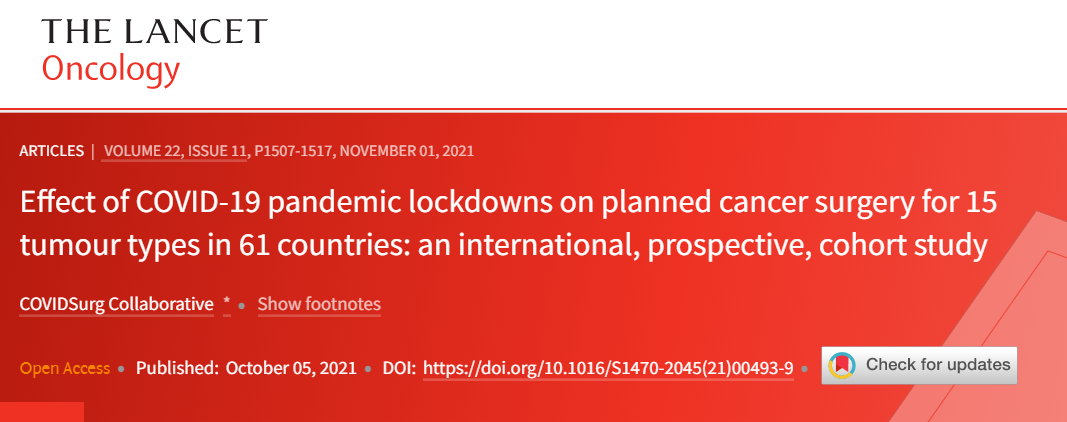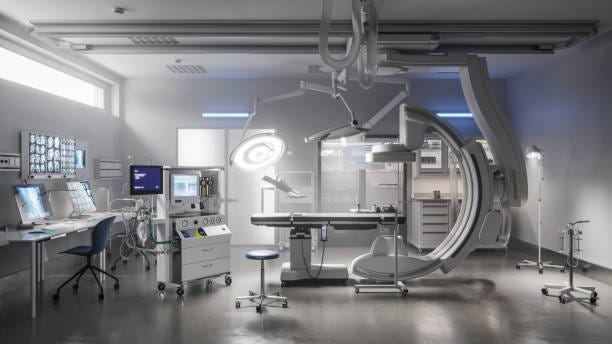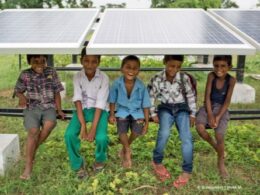Of eligible patients awaiting surgery 10·0% did not receive surgery after 23 weeks, due to COVID-19
Patients who experienced a delay to surgery during the COVID-19 pandemic might warrant strategies that support closer follow-up for metastatic disease
This is a republication of the paper below, preceded by Key Messages by the author of the blog.
Effect of COVID-19 pandemic lockdowns on planned cancer surgery for 15 tumour types in 61 countries: an international, prospective, cohort study
The Lancet
Collaborating authors listed at the end
October 05, 2021
Key messages
Summarized by Joaquim Cardoso MSc.
Digital Health Institute . AI
@ Cancer Unit
April 1, 2022
What is the impact of the pandemic on cancer surgery?
- Surgery is the main modality of cure for solid cancers and was prioritised to continue during COVID-19 outbreaks.
- In the first COVID-19 waves (ie, the 12 weeks of peak disruption), at least 21 million elective operations were cancelled globally, partly due to concerns over postoperative SARS-CoV-2 infection and partly due to capacity issues within hospitals. 7 , 8
- Of eligible patients awaiting surgery, 2003 (10·0%) of 20 006 did not receive surgery after a median follow-up of 23 weeks (IQR 16–30), all of whom had a COVID-19-related reason given for non-operation.
- Surgery beyond 12 weeks from diagnosis in patients without neoadjuvant therapy increased during lockdowns: (1) (374 [9·1%] of 4521 in light restrictions, (2) 317 [10·4%] of 3646 in moderate lockdowns, (3) 2001 [23·8%] of 11 827 in full lockdowns), although there were no differences in resectability rates observed with longer delays.
What are the causes?
- Cancer surgery systems worldwide were fragile to lockdowns, with one in seven patients who were in regions with full lockdowns not undergoing planned surgery and experiencing longer preoperative delays.
- Although short-term oncological outcomes were not compromised in those selected for surgery, delays and non-operations might lead to long-term reductions in survival.
What are the recommendations?
Taken together, patients who experienced a delay to surgery during the COVID-19 pandemic might warrant strategies that support closer follow-up for metastatic disease
During current and future periods of societal restriction, the resilience of elective surgery systems requires strengthening, which might include
- protected elective surgical pathways and
- long-term investment in surge capacity for acute care during public health emergencies to protect elective staff and services.
ORIGINAL PUBLICATION (excerpt version)

Effect of COVID-19 pandemic lockdowns on planned cancer surgery for 15 tumour types in 61 countries: an international, prospective, cohort study
The Lancet
Collaborating authors listed at the end
October 05, 2021
SUMMARY
Background
Surgery is the main modality of cure for solid cancers and was prioritised to continue during COVID-19 outbreaks.
This study aimed to identify immediate areas for system strengthening by comparing the delivery of elective cancer surgery during the COVID-19 pandemic in periods of lockdown versus light restriction.
Methods
This international, prospective, cohort study enrolled 20 006 adult (≥18 years) patients from 466 hospitals in 61 countries with 15 cancer types, who had a decision for curative surgery during the COVID-19 pandemic and were followed up until the point of surgery or cessation of follow-up (Aug 31, 2020).
Average national Oxford COVID-19 Stringency Index scores were calculated to define the government response to COVID-19 for each patient for the period they awaited surgery, and classified into light restrictions (index <20), moderate lockdowns (20–60), and full lockdowns (>60).
The primary outcome was the non-operation rate (defined as the proportion of patients who did not undergo planned surgery).
Cox proportional-hazards regression models were used to explore the associations between lockdowns and non-operation.
Intervals from diagnosis to surgery were compared across COVID-19 government response index groups. This study was registered at ClinicalTrials.gov, NCT04384926.
Findings
Of eligible patients awaiting surgery, 2003 (10·0%) of 20 006 did not receive surgery after a median follow-up of 23 weeks (IQR 16–30), all of whom had a COVID-19-related reason given for non-operation.
- Light restrictions were associated with a 0·6% non-operation rate (26 of 4521),
- moderate lockdowns with a 5·5% rate (201 of 3646; adjusted hazard ratio [HR] 0·81, 95% CI 0·77–0·84; p<0·0001), and
- full lockdowns with a 15·0% rate (1775 of 11 827; HR 0·51, 0·50–0·53; p<0·0001).
In sensitivity analyses, including adjustment for SARS-CoV-2 case notification rates,
- moderate lockdowns (HR 0·84, 95% CI 0·80–0·88; p<0·001), and
- full lockdowns (0·57, 0·54–0·60; p<0·001), remained independently associated with non-operation.
Surgery beyond 12 weeks from diagnosis in patients without neoadjuvant therapy increased during lockdowns
- (374 [9·1%] of 4521 in light restrictions,
- 317 [10·4%] of 3646 in moderate lockdowns,
- 2001 [23·8%] of 11 827 in full lockdowns),
although there were no differences in resectability rates observed with longer delays.
Interpretation
Cancer surgery systems worldwide were fragile to lockdowns, with one in seven patients who were in regions with full lockdowns not undergoing planned surgery and experiencing longer preoperative delays.
Although short-term oncological outcomes were not compromised in those selected for surgery, delays and non-operations might lead to long-term reductions in survival.
During current and future periods of societal restriction, the resilience of elective surgery systems requires strengthening, which might include
- protected elective surgical pathways and
- long-term investment in surge capacity for acute care during public health emergencies to protect elective staff and services.
Funding
See the original publication

Introduction
During the COVID-19 pandemic, government restrictions have aimed to control community SARS-CoV-2 transmission and included reducing population movement, closing public facilities, and restricting gatherings.1
Restrictions have varied worldwide in stringency, with the most severe leading to so-called lockdowns.2
Although public and media attention has largely focussed on the economic impact of lockdowns, the broader effects on general health are poorly understood.3
Lockdowns might have had collateral effects beyond controlling community SARS-CoV-2 rates alone, due to changes in both public behaviour and health system performance.4
These might have disproportionate effects on vulnerable and marginalised communities.5 , 6
Understanding these effects will justify expenditure on targeted system strengthening, as further societal restrictions are predicted at a global level.
In the first COVID-19 waves (ie, the 12 weeks of peak disruption), at least 21 million elective operations were cancelled globally, partly due to concerns over postoperative SARS-CoV-2 infection and partly due to capacity issues within hospitals. 7 , 8
In the first COVID-19 waves (ie, the 12 weeks of peak disruption), at least 21 million elective operations were cancelled globally, partly due to concerns over postoperative SARS-CoV-2 infection and partly due to capacity issues within hospitals
There was, however, general guidance from health ministries and national surgical associations that time-dependent surgery should continue. 9
This included curative cancer surgery, which is a priority among the oncology community and a high-value topic for society. 10 , 11
Surgery remains the primary method of cure for most solid cancers.
Surgery remains the primary method of cure for most solid cancers.
Since surgical databases and cancer registries do not capture prospective decision making, they lack fidelity to detect patients who did not undergo planned surgery.
In the case of curative surgery, these are the patients who might have suffered the most harm. 12 , 13
Since surgical databases and cancer registries do not capture prospective decision making, they lack fidelity to detect patients who did not undergo planned surgery.
In the case of curative surgery, these are the patients who might have suffered the most harm
Resection margins alone are an inadequate marker of success, as selection bias in patients who are able to undergo surgery risks underestimating harm from treatment delays, and neglects whole-system effects.
We planned the prospective COVIDSurg Cancer study to address these areas and provide an accurate, whole-system analysis of the impact of COVID-19 on planned cancer surgery.
Understanding any harms could allow for immediate local and national policy changes, in preparation for future societal restrictions.
Methods
See the original publication
Results
See the original publication
Discussion
The design of this study allowed a holistic overview of different health systems’ surgical capacity and outcomes during lockdowns.
The analysis allowed a direct comparison during full and moderate lockdowns to periods with light restrictions, taking account of the dynamic nature of government policies, where different patients from the same country were exposed to different lockdown states.
During full lockdowns, one in seven patients did not receive their planned operation, all of whom had a pandemic-related reason for non-operation.
This finding was robust, and consistent in sensitivity analyses.
In a secondary analysis, awaiting surgery in a full lockdown for greater than 6 weeks was associated with an increased likelihood of non-operation.
These data reveal the fragility of elective cancer surgery to lockdowns, which was independent of both local SARS-CoV-2 rates and case-mix.
Patients with cancer in LMICs, of increasing frailty, or with advanced disease were most vulnerable to lockdown effects.
Capacity for major elective cancer should be part of every country’s strategy to address whole-population health needs and prevent further collateral harm.
Capacity for major elective cancer should be part of every country’s strategy to address whole-population health needs and prevent further collateral harm.
Identifying at-risk groups allows targeted system strengthening during both COVID-19 lockdowns and future pandemics.
Firstly, vulnerable patient groups (eg, those with a poorer performance score, more cardiac comorbidities, or advanced cancers) were all less likely to receive surgery.
Secondly, certain operation types that require more intensive perioperative care, including those for oesophageal and pancreatic cancer, were at increased risk of cancellation.
Thirdly, patients in LMICs were less likely to undergo surgery during lockdowns and SARS-CoV-2 surges, which included a high proportion of young patients (<50 years).
Identifying at-risk groups allows targeted system strengthening during both COVID-19 lockdowns and future pandemics.
Protected elective surgical capacity might include protected COVID-19-free pathways
- including dedicated surgical, anaesthetic, and theatre staff — within larger hospitals, or
- smaller bespoke elective surgery units that function as part of cancer treatment networks. 20
Protected elective surgical capacity might include protected COVID-19-free pathways
This also requires long-term investment in surge capacity for the acute care workforce and formal operational planning to manage public health emergencies without major disruption to elective care (further details are in the appendix p 64).
Together, protected elective surgical capacity might allow essential elective surgery to continue despite external system shocks. 20
This also requires long-term investment in surge capacity for the acute care workforce and formal operational planning to manage public health emergencies without major disruption to elective care
The least resilient systems were in LMIC settings, exacerbating resource scarcity and capacity issues that were present prepandemic in the management of non-communicable diseases. 11 , 21 Elective cancer surgery systems in LMICs are typically under pressure from a high burden of expedited and emergency presentations. 11 , 15 , 21
This pressure was seen in our study, where the likelihood of non-operation was higher in both UMICs and LMICs, despite patients being younger and having fewer comorbidities.
These young patients were more frequently affected by financial and geographical causes for non-operation, revealing a particularly vulnerable group.
Measures to strengthen the security of global elective cancer surgery must be implemented across all settings, and as a priority in LMICs. 6
Measures to strengthen the security of global elective cancer surgery must be implemented across all settings, and as a priority in LMICs
Despite data demonstrating the safety of neoadjuvant treatment during COVID-19, the overall rate of neoadjuvant therapy as standard care or a COVID-19 decision was low (15·2%).
This low rate might represent safety concerns or highlight capacity issues elsewhere in the cancer care pathway. 22
the overall rate of neoadjuvant therapy as standard care or a COVID-19 decision was low (15·2%) .. what might represent safety concerns or highlight capacity issues elsewhere in the cancer care pathway.
Developing robust pathways from diagnosis through to definitive surgical treatment, supported by public health teams and financial protection mechanisms, will help to create both pandemic-proof and more equitable systems.
Developing robust pathways from diagnosis through to definitive surgical treatment, supported by public health teams and financial protection mechanisms, will help to create both pandemic-proof and more equitable systems.
Although we did not find an increase in the positive resection margin rate or new metastatic disease associated with increasing delays, these were highly selected patients and with short-term follow-up only.
The high proportion of patients who did not receive planned surgery reveals the true extent of potential harm.
This part of our analysis focussed on patients who were treated without neoadjuvant therapy, who are likely to represent the group at highest risk from unplanned delays.
Evidence from modelling studies and meta-analyses suggest that 4-week incremental delays before surgery are associated with increased rates of recurrence and excess mortality. 13
Taken together, patients who experienced a delay to surgery during the COVID-19 pandemic might warrant strategies that support closer follow-up for metastatic disease.
It is possible that there will be a reverse trend towards worsening cancer survival rates over the next 5 years as a consequence of these capacity issues, although the present study was not designed to directly capture these long-term effects. We acknowledge that for some cancer types, neoadjuvant therapy has equivalent outcomes to the adjuvant application of the same treatment and might be a reasonable strategy to safely delay treatment where this is required (eg, endocrine therapy for oestrogen-receptor-positive breast cancers). 23
Taken together, patients who experienced a delay to surgery during the COVID-19 pandemic might warrant strategies that support closer follow-up for metastatic disease
The impact of changes to neoadjuvant treatment pathways and both short-term and long-term oncological outcomes requires further exploration.
This study had several further limitations.
First, effects seen during lockdowns could be interpreted as normal practice, which would have occurred outside of the pandemic era.
We dealt with this by including an internal comparison (light restrictions), which is akin to normal conditions and carried a non-operation rate of 0·5%. We also collected clinicians’ reasons for non-operation, which were overwhelmingly COVID-19 related.
Second, we used the Oxford COVID-19 Stringency Index to define lockdowns, 1 calculated for each patient as the median average during their wait for surgery.
Although this index has been validated, it is not yet widely used, and the COVIDSurg Collaborative is an early adopter of this metric for research purposes. This health policy measure demonstrated association with patient level outcomes in our dataset. However, we used an aggregate summary statistic that did not reflect all changes in policy during the study period. More work is required to understand the best method to apply this measure in future epidemiological studies.
Third, as part of the exposure period to lockdowns occurred after study entry (ie, decision for surgery),
this might have been subject to future information bias, where patients remaining non-operated for a longer time might have been more likely to await surgery during different lockdown states, therefore have a central tendency in their median average score. 24
Fourth, this study required prospective capture of team decision making, which might have been subject to biases, although the scale and diversity of the study mitigated against this.
Fifth, definition of SARS-CoV-2 rates is dependent on testing performed and reported, so might vary at global scale. 17 , 18
We present exploratory analyses around SARS-CoV-2 rates stratified by income setting and provide sensitivity analyses to demonstrate that findings were robust.
Sixth, we did not present more detailed analyses of between-country or within-country variation.
Despite the large numbers in this study, individual numbers per country were low enough to risk type 1 error through multiple hypothesis testing.
Seventh, in this analysis we did not explore different hospital types or delay in care for different cancers.
There might have been hospitals that shutdown completely and did not take part in this study, meaning outcomes might have been worse. There might be specialty specific findings that allow future strategies to become stratified — eg, patients with rectal and prostate cancer might benefit from scaling up alternative neoadjuvant treatments; breast and gynaecological cancer surgery might be amenable to day case pathways; kidney, bladder, thoracic, and oesophagogastric surgery might require the advanced support of surgical units with critical care facilities; colon cancer could be performed in standalone surgical units.
Eighth, we did not capture data on delays to diagnosis. Lockdowns are a system-level issue and high friction in diagnostic pathways was likely to have led to an increasing number of tumours left undetected in the community. 25
When considering resilience of a complete elective surgery system, there is a vital role of timely diagnostics in preventing harm, which might be just as important as delays between diagnosis and surgery.
Finally, cancer care is just one component of a functioning health system.
When making policy decisions about resourcing to improve resilience, cancer must be balanced with other high-burden conditions (eg, cardiovascular and cerebrovascular disease). 26
At the time of publication, lockdowns of varying magnitude remain in place across many countries around the world, and further measures might be imposed related to novel variants of concern and variability in vaccine availability around the world (appendix p 64); however, threats to stable elective surgical systems are not limited to COVID-19; other viral pandemics, seasonal pressures, and natural disasters all affect surgical patients on an annual and recurring basis.
The lessons from this study might be used to inform surgical system strengthening both during the COVID-19 pandemic and beyond.
Data sharing
Anonymised individual participant data will be made available upon request to the corresponding authors after the date of publication, with approval of the operations and dissemination committees, and completion of a data sharing agreement.
Contributors
See the appendix for the complete list
The writing group (JCG, AAde, AAdi, EA, APA, FA, JA, AMB, AC-C, JE, ME, MF, CF, GG, DG, EAG, EH, PH, IL, SW, HL, SL, EL, GMAG, HM, EJM, JM, DM, KM, MM, RM, DM, FN, FP, MP, PP, AR-DM, KR, ACR, RKS, RS, JFFS, NS, GDS, RS, SS, ST, EHT, RV, DN, AAB)
and the statistical analysis group (JCG, KAM, DN, EH, AAB) contributed to writing, data interpretation, and critical revision of the manuscript.
Collaborating author list (PubMed citable).
Writing Group
James C Glasbey (UK), Adesoji Ademuyiwa (Nigeria), Adewale Adisa (Nigeria), Ehab AlAmeer (Saudi Arabia), Alexis P Arnaud (France), Faris Ayasra (Jordan), José Azevedo (Portugal), Ana Minaya Bravo (Spain), Ainhoa Costas-Chavarri (Rwanda), John Edwards (UK), Muhammed Elhadi (Libya), Marco Fiore (Italy), Christina Fotopoulou (UK), Gaetano Gallo (Italy), Dhruva Ghosh (India), Ewen A Griffiths (UK), Ewen Harrison (UK), Peter Hutchinson (UK), Ismail Lawani (Benin), Samuel Lawday (UK), Hans Lederhuber (Germany), Sezai Leventoglu (Turkey), Elizabeth Li (UK), Gustavo Mendonça Ataíde Gomes (Brazil), Harvinder Mann (UK), Ella J Marson (UK), Janet Martin (Canada), Dennis Mazingi (Zimbabwe), Kenneth McLean (UK), Maria Modolo (Argentina), Rachel Moore (South Africa), Dion Morton (UK), Faustin Ntirenganya (Rwanda), Francesco Pata (Italy), Maria Picciochi (Portugal), Peter Pockney (Australia), Antonio Ramos-De la Medina (Mexico), Keith Roberts (UK), April Camilla Roslani (Malaysia), Rajkumar Kottayasamy Seenivasagam (India), Richard Shaw (UK), Joana Filipa Ferreira Simões (UK), Neil Smart (UK), Grant D. Stewart (UK), Richard Sullivan (UK), Sudha Sundar (UK), Stephen Tabiri (Ghana), Elliott H Taylor (UK), Raghavan Vidya (UK), Dmitri Nepogodiev (UK), Aneel A Bhangu (UK, Overall Guarantor)
Originally published at https://www.thelancet.com












